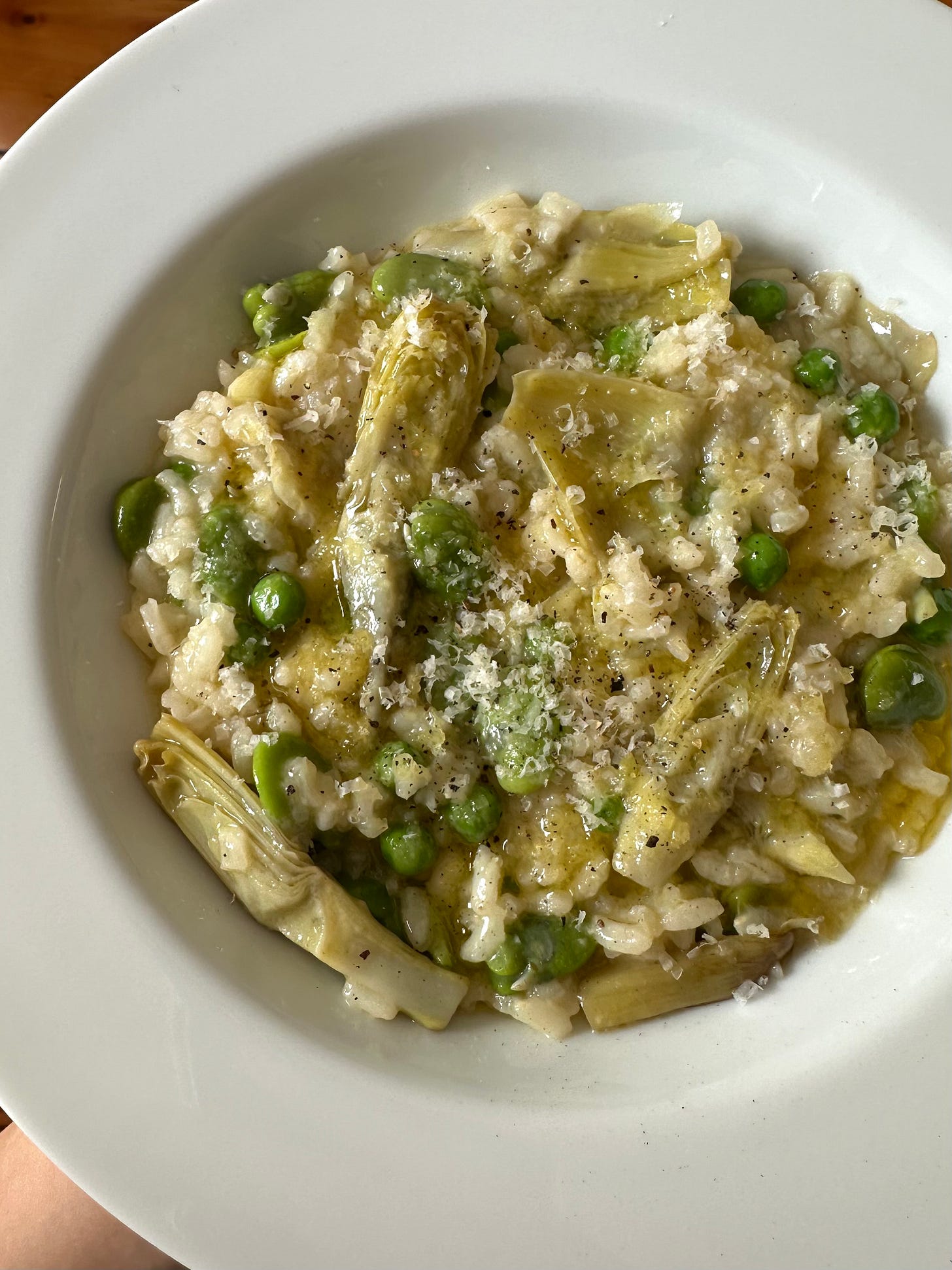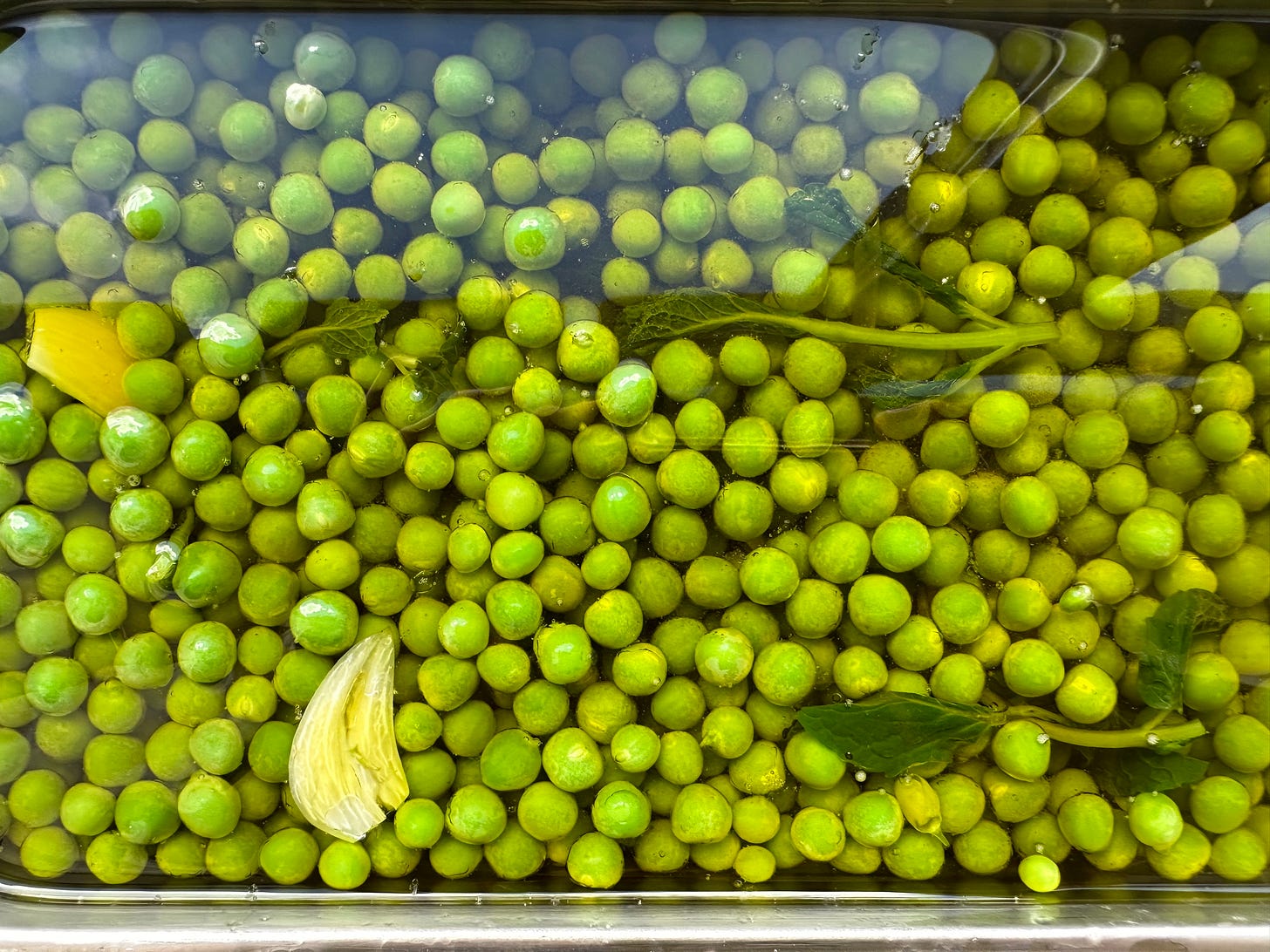Risotto alla Vignarola
On gloomy Spring evenings, a warm, brothy bowl of risotto provides unbeatable comfort. This risotto is very similar to the Venetian Risi e Bisi, but with a couple of extra guests.
Now that we are in peak spring, each week begins with blanching fava beans, preparing peas sott’olio, and poaching baby artichokes. Preparing batches of these ingredients makes it easy to create seasonal dishes based on what my clients crave. This is often determined by the unpredictable weather during these months. For an evening outing in the park, I folded the prepared vegetables into Vesuvio pasta with homemade basil pesto and arugula. This short, curly pasta with a semi-hollow corkscrew shape is named after Mount Vesuvius in Campania, Italy. It catches pesto in its crevasses, creating explosive bites of flavor. A few splashes of the artichoke poaching liquid lent acidity needed to round out this pasta salad.
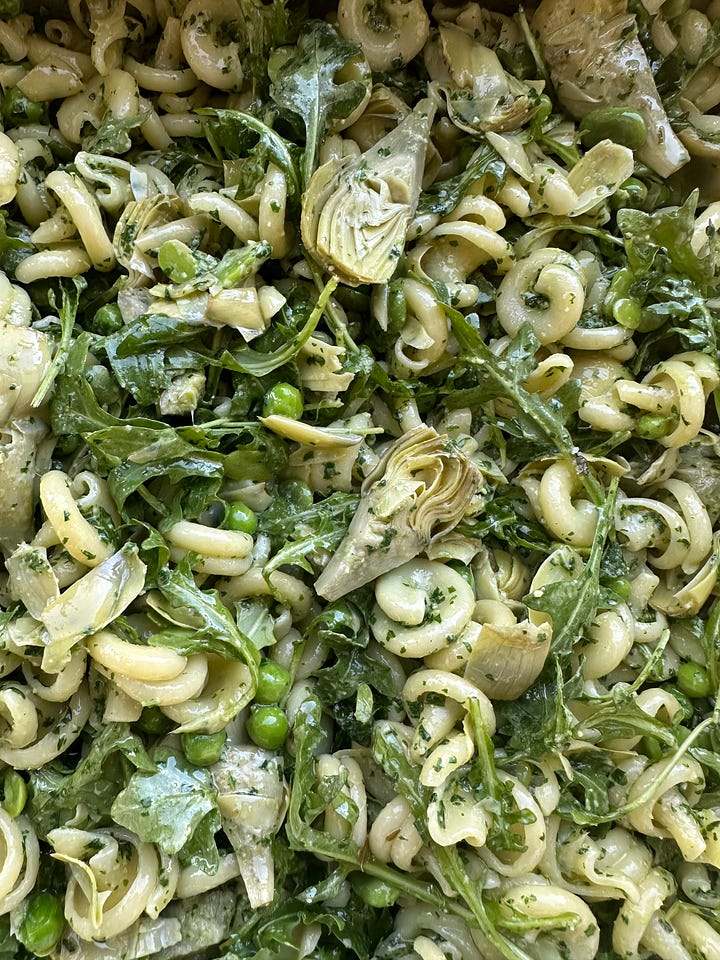
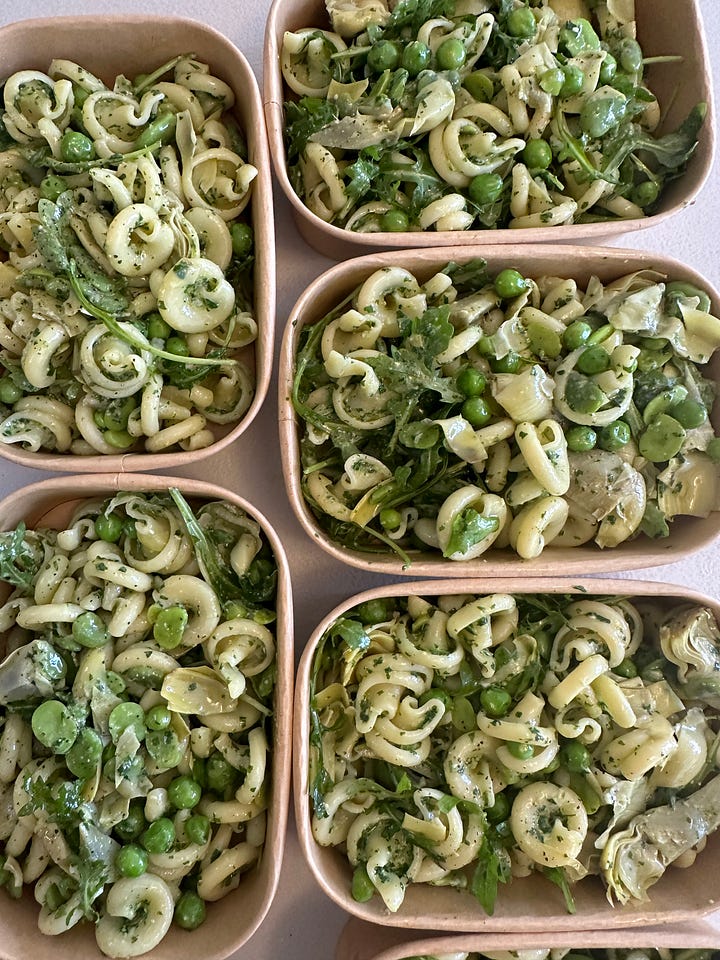
Vignarola is a traditional Roman stew made usually from April to late May, when broad beans, peas, and artichokes overlap at the market. Here in New York, we see these ingredients much later in the season at our markets, but thankfully, through Baldor by way of Eataly, we can enjoy them now. I love the versatility of preparing vignarola; a vegetable braise built atop crispy guanciale or pancetta and melded together some white wine or vermouth, whatever spring alliums I find at the market, and maybe some broth. Sometimes, I’ll add asparagus or market greens, finish with some lemon zest and juice, and almost always mint from my Dad’s garden for freshness. It makes a lovely side to a roast lamb and atop some torn burrata or fresh ricotta.

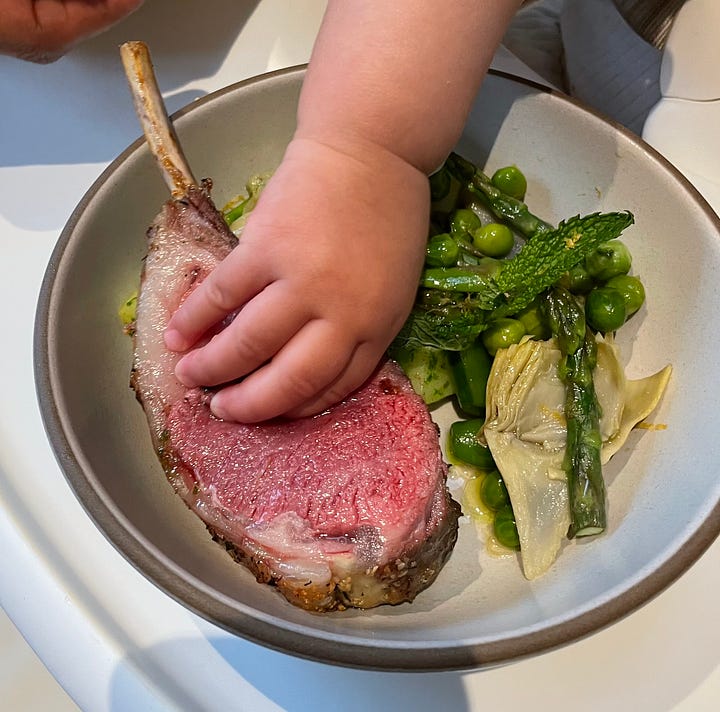
On gloomy spring evenings, a warm, brothy bowl of risotto provides unbeatable comfort. This risotto is very similar to the Venetian Risi e Bisi, but with a couple of extra guests. A couple of weeks ago, I arrived at my clients on a stormy evening to prepare this dish, and it eased everyone’s concerns about the dining room flooding.
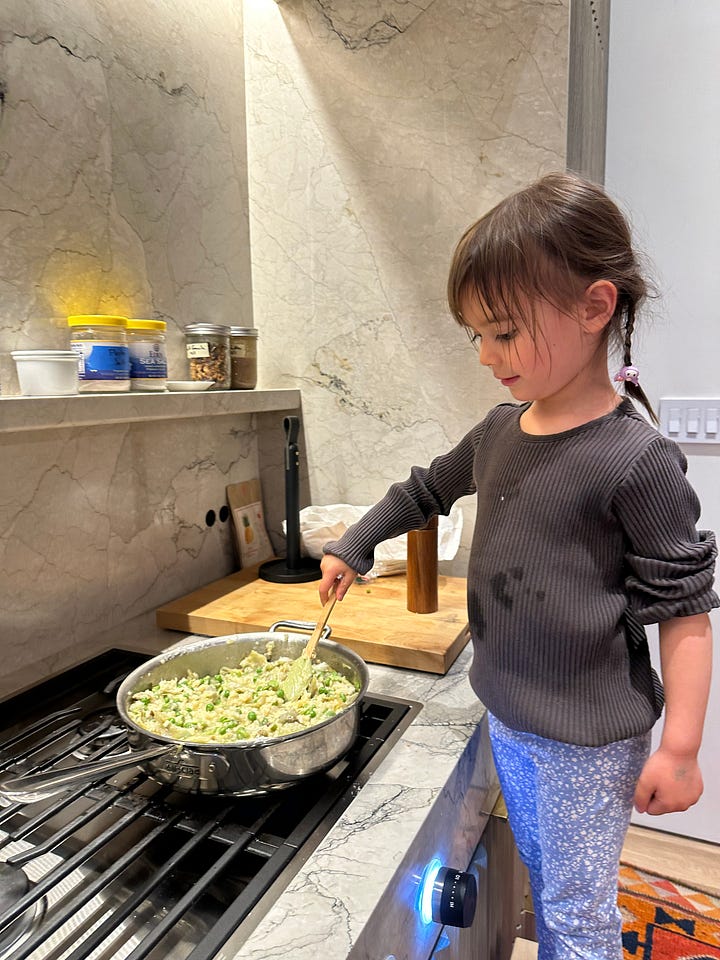
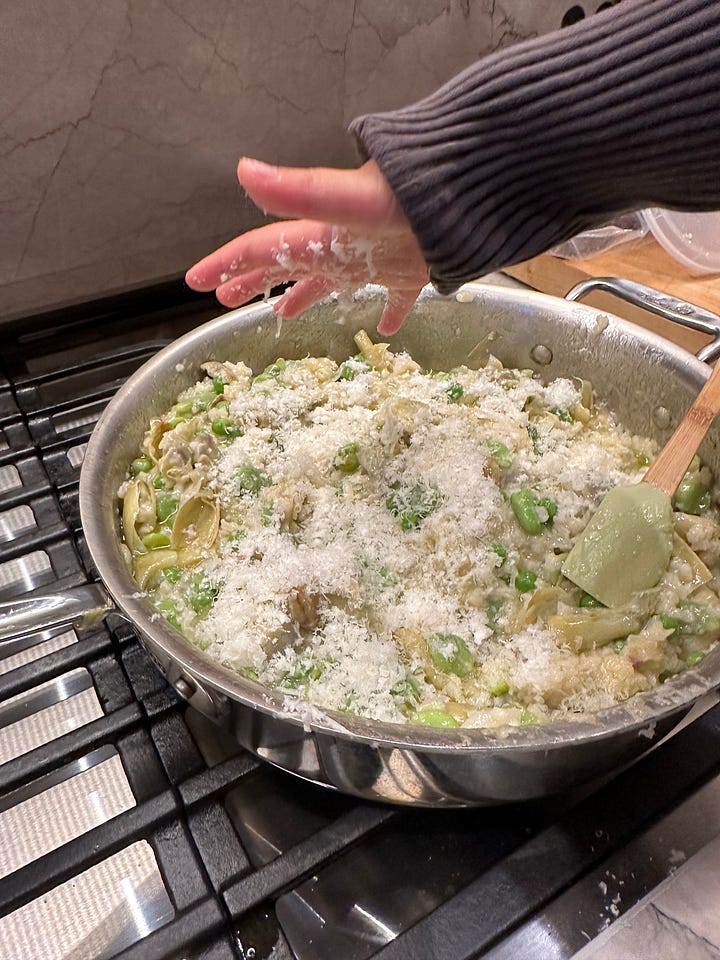
It’s a crowd-pleaser for vegetarians and kids or a romantic evening for two. Before I was pregnant, I enjoyed this dish with a cold glass of dry white wine.
In a previous post, I wrote about how quickly we run through our homemade bone broth. The only bone broth I trust in supermarkets is the frozen bonafide organic chicken bone broth, which is excellent and gelatinous but quite expensive. To supplement here without purchasing too much bone broth, we simmer the pea shells to make a pea broth, a lovely aromatic and zero-waste compliment to the dish and a great vegetarian substitute. When preparing this for clients or my family, I’ll prepare all the vegetables ahead of time, grate cheese, and par-cook the risotto. That way, it can be finished in about 5-10 minutes when it's time to serve dinner.
Risotto alla Vignarola
Ingredients
Poached Baby Artichokes
Baby artichokes
Lemons
Dry white wine
Extra-virgin olive oil
Fresh thyme sprigs
Fleur de sel
Peas Sott’olio
Fresh Peas
Fresh garlic, germ removed and smashed
Fresh mint springs
Sea salt
Extra-virgin olive oil
Risotto all Vignarola
Extra-virgin olive oil
Vialone Nano, Carnaroli, or Arborio rice (about 1 cup for every 2 servings)
Yellow onion, diced
Garlic, finely minced
Dry white wine
Chicken bone broth (frozen bonafide preferred; I buy at least 4 bags for 4-6 servings and supplement with pea stock if needed)
Pea stock (optional, reserve pea pods when shelling to make)
Poached baby artichokes, quartered
Peas sott’olio, most oil drained
Fresh Fava beans, shelled
Method
Poached Baby Artichokes
Fill a large bowl with cold water, squeeze in some lemons, and toss the lemons into the bowl. Snap back the outer leaves of the baby artichokes until you reach the soft yellow core. Using a peeler, peel away the textured base of the artichoke and the fibrous outer layer around the stem until everything is completely smooth. Chop off the bottom part of the stem and about 1-2” off the top of the leaves.
Transfer cleaned artichokes to the bowl of lemon water as you work, covering them with a clean kitchen towel to keep them completely submerged. Add artichokes to a saucepot and cover with half white wine and half extra-virgin olive oil. You can add some water to preserve your use of wine and olive oil here. Add a large pinch of fleur de sel and a couple of thyme sprigs.
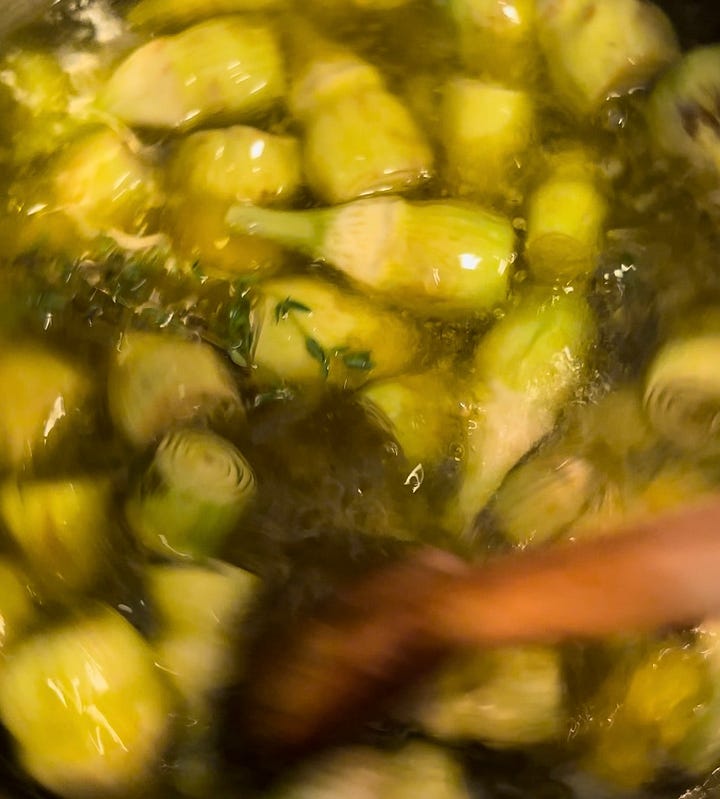

Bring artichokes to a steady simmer and cover with a parchment cartouche to keep them completely submerged. Let the artichokes simmer until easily pierced with a knife and the leaves are tender. Once the artichokes are fully cooked, transfer to a heat-proof dish or bowl to cool and cover with the poaching liquid. Allow them to fully cool before storing them in the fridge. Baby artichokes preserved in liquid can be stored in the refrigerator for 7-10 days.
Peas Sott’olio
Bring a saucepot with water salted like the sea to a boil, and add smashed garlic cloves and mint sprigs to season the water. Once boiling, add the peas and let simmer until soft. Once soft, transfer the peas to a dish and cover immediately with olive oil. Allow them to fully cool before storing them in the fridge. Keeps in the refrigerator for up to 2 weeks.
To prepare pea stock, reserve the pods after shelling, rinse off, boil, then simmer until reduced by half, about 30 minutes.
Fresh Fava Beans
Boil freshly shelled fava beans for about four minutes, then shock in ice water immediately. Peel and discard the outer layer of the bean, and store it in the fridge for 1-2 days.
Risotto all Vignarola
First, get your chicken bone broth and/or pea stock simmering. Sauté diced onion and minced garlic in olive oil until translucent. Add rice and toast, tossing to meld the flavors and release the rice's starches. Pour in white wine, let it simmer, and cook off. Once the wine has been absorbed, slowly ladle the warm chicken bone broth and/or the pea stock into the rice, stirring continuously. Ladle more broth and stir until the rice is plumped up and cooked to your liking.
If I’m prepping ahead, I’ll transfer the risotto to a sheet tray to cool evenly, then store it in the fridge until it’s time to serve. That way, I can quickly finish the dish without it tasting mushy or the grains being overcooked.
Once the risotto is soft but still has a bite, fold in grated Parmigiano Reggiano, the peas, some of their olive oil, fava beans, and quartered baby artichokes. Adjust seasoning to taste, then spoon into bowls. Finish with freshly grated Parmigiano Reggiano, freshly cracked black pepper, and a drizzle of your best olive oil.





